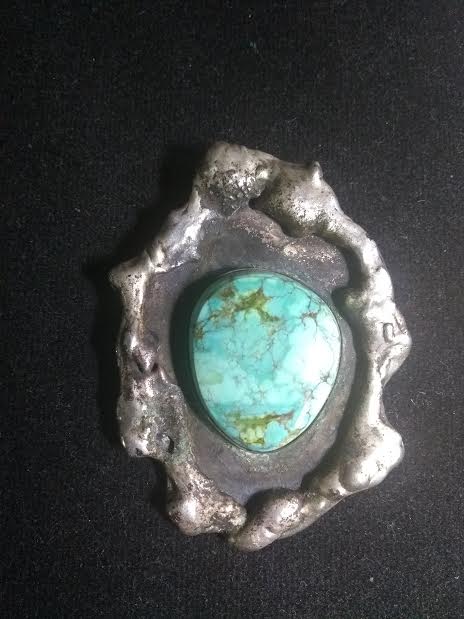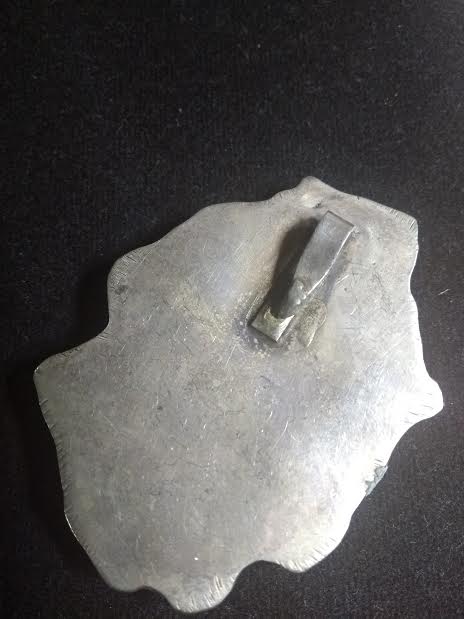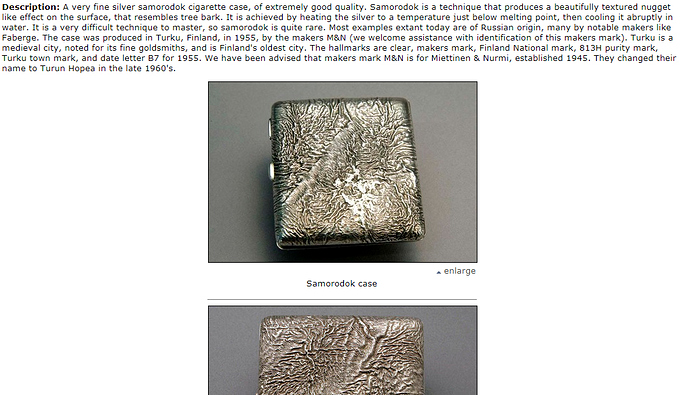My dad picked this up in AZ or NM years ago. Has anyone seen another artist that uses a melted edge like this? The bail on the back is very simple the edges still show file marks and there is no stamping or hallmarks but it is silver. Its about 3" x 2"
I have seen it, but not with any specific attribution. I think of this as sort of a “brutalist” style, but not sure if it was used by a certain maker, or just a few artists experimenting with technique.
I suspect it was a fad technique among non-Native hobbyists, maybe '60s-70s when Art Nouveau/organic design became very popular again. I can’t add anything more specific.
" Samorodok is a Russian word meaning that the metal is in its pure or natural state."
source: http://www.silvercollection.it/dictionarysamorodok.html
what your pendant appears to be is molten silver poured onto the pendant base freeform edge and cooled. there is 1 small area where it flowed over the side and can be seen from the back.
Samorodok* is a Russian word meaning that the metal is in its pure or natural state. The samorodok (reticulation) technique produces a textured nugget like effect simulating a molten surface. This result is obtained by heating gold or silver to a temperature near the melting point and cooling it abruptly in water.*
Thanks Steve, We do this process in the shop but we just call it reticulation. By heating the metal several times then quenching and pickling you remove the copper from the surface. This builds a layer of wrinkly fine silver on the surface that doesn’t tarnish easily. You can make some very dramatic pieces like this cuff I saw on the internet. Maybe I’ll adopt the Russian word…it’s more exotic ![]()

That pendant of your dads is cool It reminds me of how learning the art of metalsmithing kinda makes you feel like an Alchemist! I am a scientist and an artist and this is exactly the kinds of things I used to do alomg with make my mistakes unto treasures and always push the boundaries of what your “supposed” rules your to follow while making something. I always let the pieces lead me rather than the drawn out plans lead the work. I believe in serendipitous interventions that take over as a result of every piece being a learning process. A lot of my work is one of a kind because of that. I have used both the melting technique and the reticulation technique. Its called reticulation because of the scaley snakelike patterns you get from it. Have you ever done Keum boo or Mokume? I have seen somehigh end NA artists use these. They are amazing and can be very nature inspired and have that experimental genius that your dad seemed to have.
~Koliopee
I have experimented with the Keum boo but to be honest I was not impressed with my work  so I haven’t done much. I have see some very nice pieces by others, Kyle
so I haven’t done much. I have see some very nice pieces by others, Kyle
The work looks like a single piece of sheet melted inward from the outside edges to form the melted border.
Artistic merit is in the eye of the beholder, but essentially the value in this piece is raw metals value, and the value of the stone only.
This looks like an experimental piece created by a novice silversmith, or metalwork student.


